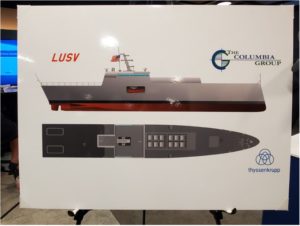The head of the House Armed Services Seapower and Projection Forces subcommittee said Congress wants to see more prototyping and testing of larger unmanned vessels before they will fully fund the new classes of ships.
Given the importance of large unmanned ships in the Navy’s latest shipbuilding plan and strategy documents from late last year, “I do think we want to see more, in terms of just the prototyping and testing. We just do not want to go rushing headlong to starting a shipbuilding program of larger vessels because as we all know, turning those off is not easy,” chairman Rep. Joe Courtney (D-Conn.) said during a discussion at a virtual Hudson Institute event on Feb. 18.

Courtney directly referred to the Littoral Combat Ship (LCS), which had many development issues and continues to have additional issues crop up. Last month, the Navy stopped accepting delivery of the Lockheed Martin [LMT] Freedom-variant LCS after finding a material defect with the combining gear (Defense Daily, Jan. 22).
Courtney called the LCS the “poster child of procurement that just really kind of got lost in terms of just what was the mission and then obviously we’re having these persistent problems with the combining gear, malfunctions that are out there.”
“We don’t want to overlearn that lessons, but I think it’s still important for us to really keep our eye on the ball as far as that goes.”
In December, the Navy released several fleet planning documents that talk about the importance of unmanned vessels in the future fleet.
The Defense Department released a new Tri-Service Maritime Strategy in December that said the force plans to reach a larger fleet with many small and unmanned ships spread across the Pacific region to help counter growing Chinese naval power (Defense Daily, Dec. 17).
That same month, the Navy released its 30-year shipbuilding plan that outlined plans for the service to have 21 unmanned platforms by FY ’26, including 12 Large Unmanned Surface Vessels, before later ramping up production to many dozens or hundreds of unmanned vessels in future decades (Defense Daily, Dec. 10).
Moreover, last October, Chief of Naval Operations Adm. Mike Gilday said unmanned vessels will help fill in gaps in intelligence, surveillance, reconnaissance and targeting (ISR&T in the planned future distributed naval force. He also said unmanned systems offer possible utility in larger numbers of vessels, distributed firing, command and control nodes and electronic warfare capabilities at a more affordable cost than with manned ships (Defense Daily, Oct. 14, 2020).
However, Courtney reiterated Congress’ reluctance to move forward too quickly before more testing work is done. When the House Armed Services Committee was working on the FY ’21 defense authorization bill last year, committee staffers said the meaning of several provisions was wariness of moving to serial production too quickly if unmanned vessels include capabilities the Navy does not completely understand.

The House Armed Services Committee’s version of the FY 2021 defense authorization bill prohibited the Navy from procuring any Large Unmanned Surface Vessels (LUSVs) until a technology maturation certification is submitted to Congress. This guarantees the hull, mechanical and electric systems of LUSVs have at least attained technology readiness level seven and can be autonomously controlled for at least 30 days (Defense Daily, June 23, 2020).
The committees also recommended cutting two LUSV prototypes until the Navy can provide enough design maturity and show it understands autonomy issues.
“You’re creating constituencies when you create contracts for those types of investments and frankly there’s still some, I think, legitimate questions that need to get fleshed out and can be fleshed out by using sort of land-based testing systems and really again also thinking about what exactly do we want these vessels to do,” Courtney said on Feb. 18.
The chairman said they do not mean to obstruct unmanned vessels for the Navy, but want to see more answers, particularly in how larger vessels are developed.